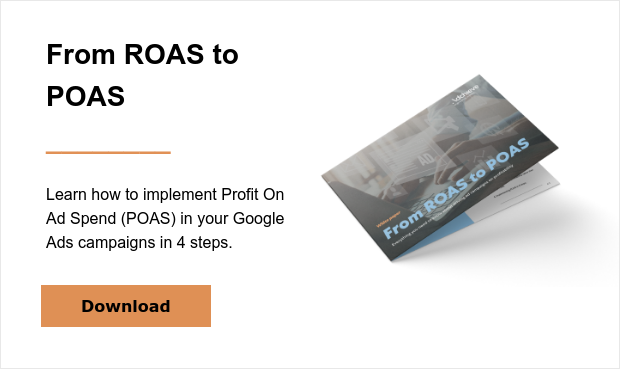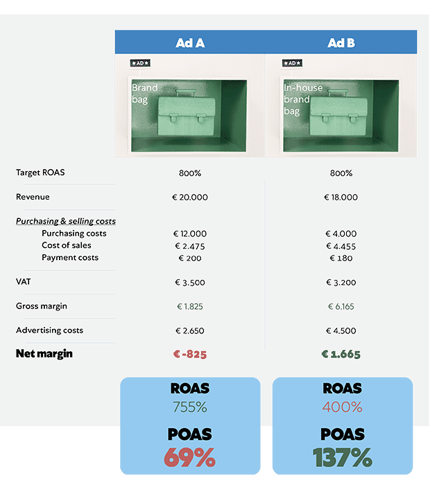Tip: Download the guide: From ROAS to POAS and learn how to implement Profit On Ad Spend step-by-step in your campaigns.
ROAS goals and target ROAS
But first, back to the ROAS. The ROAS shows what a specific ad group/campaign or even keyword has delivered in terms of conversion value. There is an important difference between a ROAS goal and a target ROAS.
You can define a ROAS goal at all kinds of levels. Sometimes 1 goal is pursued for an entire account. Another option is to set a ROAS goal per product category or brand, for example. This way you can have multiple ROAS objectives within a single company.
Target ROAS is another story: that’s Google’s bidding strategy. For example, if you set the target ROAS to 500%, Google aims to generate at least 5 euros in revenue for every euro spent on clicks. If you sell shoes with a turnover value of 200 euros – and that sale comes through Google Ads – then Google may not spend more than 40 euros on clicks.
ROAS: your sales can be misleading
The ROAS (for example 800%) is in fact quite a simple calculation. It is the revenue from advertising divided by the advertising costs x 100%. In this sum you do not take the margin of the ad into account.
For a ‘ROAS Advertiser’ the results of an ad revenue of € 500, ad cost of € 50 and a margin of 25%, therefore match those of an ad revenue of € 500, ad cost of € 50 and a margin of 50%.
According to the above calculation, both advertisements have a ROAS of 1000%, because 500/50 * 100% = 1000%.
Because you treat all products with the same sales price and sales numbers equally by looking at only sales, this has a big impact on bottom-line profit. It may be so that you have nothing left or even suffer losses in the end. I will explain later in this article how that works.
POAS target: why is ROAS shifting to POAS
Let’s explain POAS. Why is ROAS shifting to a POAS target? Well, let me explain. POAS may be a new term, but the method already existed. Some organisations have been steering based on a POAS objective for years. However, most organisations still look at a ROAS objective, simply because it is easier to set up. By placing a special pixel on the site, the turnover can be retrieved from the order confirmation page relatively easily. Profit value will not be shown here, because this is competition sensitive information.
In addition, every organisation calculates the profit value in a different way, and certain important choices are made as to which costs are or are not included. It is also important to mention that most marketers want to maximise sales, and are simply not settled on the basis of a profit target.
Why then the shift? The shift from ROAS to POAS is mainly taking place because the optimisation options within campaigns are increasingly disappearing.
To gain competitive advantage in campaign types such as Performance Max, it is therefore increasingly about who can send the best data signals to Google. Is your competitor taking profitability into account and you’re not? Then there is a good chance that you will lose the conversions with the highest profit value. You are then left with the conversion for which you get little value in return, or even incur losses.
So, how to use POAS target?
You can prevent a wrong image of your results by comparing not the turnover, but the margin per advertisement against the costs, and so be able to see the profitability per advertisement. That is the POAS: the Profit On Ad Spend. The POAS is also the profit (better still: gross margin) per ad divided by the advertising costs.
In the example below, you can see how an e-commerce marketer looks at how two different bag ads work, using ROAS and POAS:
Explanation: In the example, A is a brand bag and B is an in-house brand bag. In ad A, the ROAS comes closest to the target and therefore ad A seems to perform better than ad B, where the ROAS significantly deviates from the objective.
You probably would have stopped ad B based on ROAS, while that would be the wrong choice. But if you finally look at the profitability of the ads, you see that ad B (POAS> 100%) actually wins. POAS <100%, in the case of ad A, means that your margin is less than your Ads costs and that you therefore suffer losses.
Important to note: it could be that someone comes on your website after clicking on an ad for a specific product and then buys a different product with a different margin than the product you were advertising with. That is why we also speak of the margin per advertisement.
POAS target: bet on profitable campaigns
The focus on POAS ensures that you will make smarter choices with a positive effect on the profitability of your campaigns. You avoid stopping the wrong campaigns or putting money into campaigns that at first glance seem profitable, but are not.
Is POAS also beneficial for my organisation?
You can determine whether POAS is suitable for you in the following way. For each advertisement, can you easily calculate what you earn from it? If the margin is roughly the same for each product, then you can calculate the margin based on the conversion value at each level (account, campaign, adgroup, etc.) based on Google Ads data.
Please note: other costs (shipping, payment, warehouse costs, etc.) are not included in this, and these are of great impact. For that reason alone, a more advanced method is recommended.
Is there also a difference in your margins per product? Then you always need to use a different method. Below I explain how you can apply POAS in four steps.
Implementing POAS in 4 steps
We will explain in 4 steps how you implement POAS in Google Ads:
Step 1: Create new Purchase conversion action in Google Ads to measure profit
Start by creating a conversion action to track purchases on your website. Set this conversion action to ‘secondary’. This because we don't want this conversion action to report extra conversions that are used for bidding (which is the case with primary conversion actions). We add this conversion action for the purpose of observing the profit in Google Ads to act on it, not for direct bidding.
Make sure your Transaction ID is measured . This is necessary for step 3 to work properly, because you are going to tell Google what the conversion value per measured conversion should be, based on the transaction ID. One popular way to set up conversion actions with Transaction ID’s is via Google Tag Manager (more info here and here).
The conversion value measured by this conversion action will be ‘profit’. In your tag/conversion action setup you will use a placeholder for the conversion value, this can be a random number, because you will replace it in a later step with the correct/actual profit per conversion.
The rest of the settings in the conversion action and tag will be the same as your regular primary Purchase conversion action you have set up. This way this conversion action will be almost the same as your primary Purchase conversion action. The only differences should be that it measures the profit in stead of the full revenue and that it is a secondary action with the goal of observation, not bidding.
Click on the image to enlarge
Step 2: Determine gross profit per transaction ID
The next step is to determine the gross profit per transaction.
For this you have to first determine the revenue per transaction (order) that resulted from your ads. This is important because a lot of transactions that resulted from Ads contain more products than just the advertised ones, so you definitely want to take that into account.
Then you determine the cost of these transactions. Here you take the purchasing costs of the products into account, but also order costs, like shipping, handling and payment costs.
With this information you can now calculate the gross profit per transaction ID by simply subtracting the costs of the transactions from the revenue. You can calculate this yourself using Excel for example, but this can be time consuming and error-sensitive.
Adchieve software will save you a big headache in this process, because our tool will automatically retrieve all the necessary data and performs all the calculations you need. It will also automate the next step: uploading your gross profits to Google Ads.
Step 3: Upload gross profit per transaction ID to Google Ads
Now that you have calculated the actual profits per transaction ID, you are going to upload them to Google Ads. If you are not using a PPC tool like Adchieve you have to do it manually -every day- by preparing a spreadsheet with the information Google requires.
By using the ‘restate’ adjustment type in your spreadsheet you are able to tell Google to change the conversion value to the actual profit per transaction ID. Read here how to prepare the spreadsheet and upload it to Google Ads.
Step 4: Add custom columns with POAS and Net margin to Google Ads
The last step is to add custom columns to your Google Ads to be able to manage and optimize your campaigns on profitability.
To create a custom column go to: Campaigns → Columns → Modify columns → Custom columns → +Column (more detailed instructions here)
Use the math operators to create the desired column conditions:
- POAS = Conversion value (filter by Conversion source, select new conversion action) / Ad cost
- Net margin = Conversion value (filter by Conversion source, select new conversion action) – Ad cost
When you save you will be taken back to the ‘modify columns’ page. There you select your new columns and click ‘Apply’ to be able to view and work with it in your Google Ads reports.
Click on the image to enlarge
Voilà! You're now all set to start optimizing your campaigns on POAS!





